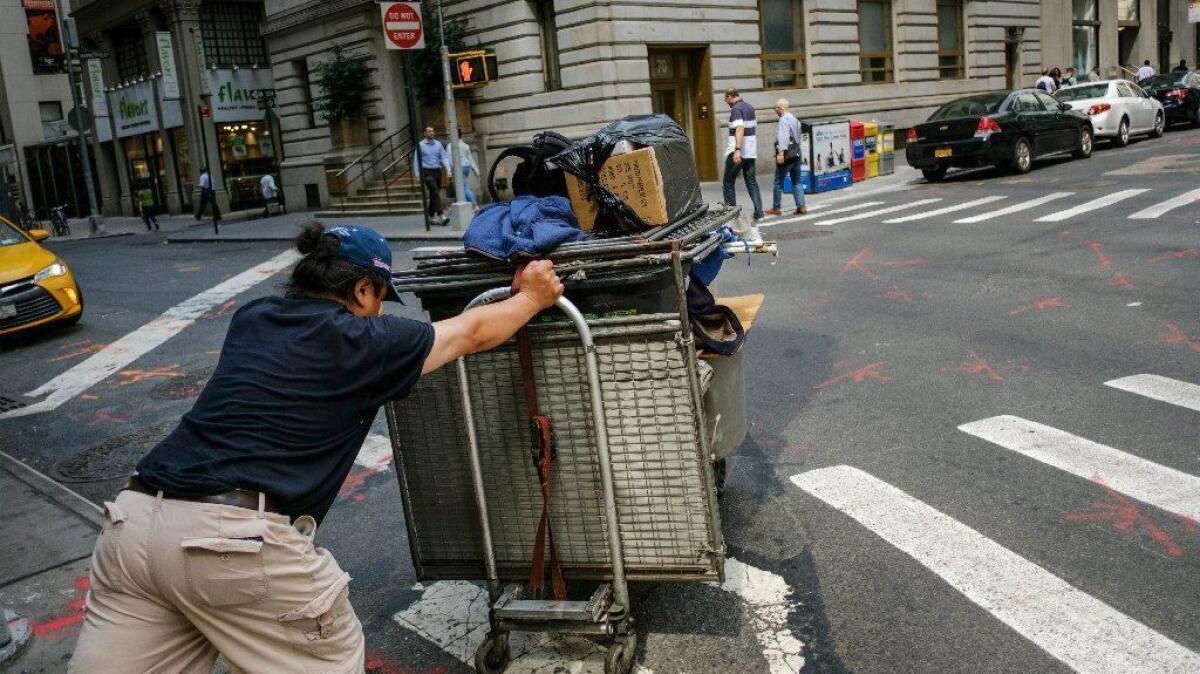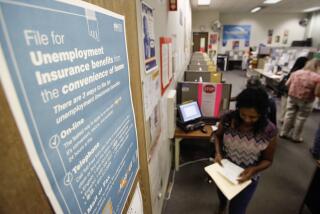Tight job market is good for felons, people with disabilities and others who are hard to employ. But can it last?

At 49, Marshall May Jr. could not remember whether he had ever taken his mom out for a meal.
Certainly not in the last 20 years when he was in and out of prison, serving seven separate terms for crimes like stealing to support his drug habit. He last held a regular job in 1994, as a front desk clerk in a Century City hotel.
But this spring May was hired as a part-time street sweeper by Chrysalis, a nonprofit serving the homeless, and that helped him land full-time work as a healthcare peer specialist for which he is now getting trained. He still does not have a place of his own, but with a job in hand, May figures he at least has a shot now. After getting back on his feet, he took his 83-year-old mom to dinner on Mother’s Day.
“It was an incredible feeling,” he said. “I spent a lot of time at the table crying.”
As the nation enters its ninth year of economic expansion next month, the low unemployment and tightening labor market have begun to open doors for people like May, who not long ago had all but given up any hopes of returning to the workplace.
Thus far the improvement for the hard-to-employ has been relatively small and spotty, confined mostly to places with exceedingly low unemployment, like in the Midwest and states like Colorado, where the 2.3% jobless rate is the country’s lowest. The nationwide unemployment figure was 4.3% in May, a 16-year low.
During the Great Recession and immediate aftermath, joblessness surged and reached a high of 10%. Millions of people in the prime of their work lives, mostly men, lost jobs in manufacturing, construction and other industries. Since then some have returned to the labor market, but many remain unaccounted for, as if they had vanished from the economy. An opioid epidemic in rural America and swelling numbers getting incarcerated or on government disability have added to the startling decline in employment levels.
But if decent job growth keeps up as most economists expect, groups with historically high unemployment — people with criminal records, disabilities, low skills or little education -- could make some real gains, as they did in the late 1990s.
Already, the jobless rate for adults with less than a high school diploma is down to 6.1%, less than half of the level five years ago and close to a quarter-century low of 5.8%, according to government data. For workers with just a high school education, unemployment most recently was 4.7%, compared with an all-time low of 3.2% in November 1999. These two groups represent about one-third of America’s workforce of 160 million.
The labor shortage is pronounced in booming metros like Austin, Texas. Businesses are so desperate for workers there that they recently teamed up with community colleges, labor unions and nonprofit organizations to train people for jobs such as light industrial work, nursing assistants, information technology support and office clerical help.
“We have employers more open to hiring people with criminal backgrounds than we’ve ever seen before,” said Traci Berry, a senior vice president at Goodwill Central Texas, part of the nationwide network of nonprofit community job-training and placement services.
Even in California where unemployment statewide is typically higher than the national average, the latest jobless rate of 4.7% in May -- the lowest since November 2000 — has begun to benefit job developers like Chrysalis. Last year it secured positions for 2,350 homeless, ex-offenders and other long-term unemployed, up 17% from 2013 and double the number placed into jobs in 2008. Chrysalis’ support from private donors also is sharply higher.
“It’s great that they’re finding success now. It’s great that employers are more open to bringing them on,” says Chrysalis’ chief executive, Mark Loranger. “But I do wonder, have they really changed their attitudes on hiring people with backgrounds? … When the economy turns on our clients, will things go back to being extraordinarily difficult?”
History is not too encouraging. Even during the record-long expansion of the 1990s, when unemployment was lower, productivity higher and wage growth stronger than the current growth period, hopes that rose toward the end of the decade were dashed as the economy tipped into recession in early 2001 with the tech-stock bust and later, the effects from 9/11.
Georgetown University economist Harry Holzer is less optimistic today than at the turn of the last century. More workers have multiple barriers to reentry, such as dependence on drugs and government disability programs, he said. And the labor market is not red hot as it was back then, when unemployment was below 4% during much of 2000.
“A lot of employers were so desperate for bodies that anyone who was marginally employable, they were willing to look at,” said Holzer, who was chief economist in the Clinton administration’s Labor Department in 1999.
More recently, Holzer and fellow researchers have advocated a range of policy steps, including changes in disability programs and expanded wage subsidies, to help jobless men get back to work.
How long the current job gains will last for those at the bottom is anybody’s guess. Employers like Norm Sedelbauer, a manufacturer of electronic locks in Grand Rapids, Mich., isn’t making any promises. Recently he hired Allen Helmer, 48, who is blind in one eye and has been mostly unemployed since he was laid off from a book-binding company in 2007.
Helmer says he hopes he can stay on at Bauer Products for awhile. He makes $10 an hour, barely enough to pay for groceries and the mortgage on a house his parents once owned. “I have to choose between eating and having fun,” he said. At work, Helmer stands from 8 a.m. to 4:30 p.m. assembling and jiggering locks with his muscular hands, but said he feels good at the end of the day when he takes the bus back home.
“I like working with my hands, I like putting things together,” he said. “It doesn’t pay extremely well, but it’s well worth it.”
The jobless rate for workers with disabilities reached nearly 17% in the summer of 2011 but has since dropped to 9.5%.
Helmer got his job at Bauer through Goodwill in western Michigan, but many job developers worry about cuts in public dollars to help people reenter the labor market. President Trump’s budget has proposed substantial reductions, for example, in job-training funds that support efforts by outfits like Goodwill, although some of that federal money would be diverted to enhance apprenticeship programs.
“Now we ride the economic waves again, but the funding is not there today,” said Kathy Crosby, a 38-year veteran of Goodwill.
Even so, Crosby and other experts are hopeful especially for those coming out of prison. Budget-conscious states and counties are increasingly looking at early-release programs and tying them to jobs, figuring that helping them find work will make it much less likely that they will return to prison.
Maine, for example, released a small number of inmates with nonviolent offenses to fill job openings that swell in the summer tourism season. Maine’s unemployment is 3.2%.
In many parts of the country a worsening labor shortage in construction could open up job pathways for men with records. Employer attitudes toward hiring ex-offenders also seem to have softened somewhat as a growing number of states and cities have sought to remove employment barriers for former prisoners since the Great Recession.
Isaac Vallejo, 53, used to operate his own auto body shop in Austin. He lost the business when he went to prison several years ago for illegal possession of a firearm. Vallejo says he had carried it because he often had a lot of cash on him. It was his second felony offense and he was sentenced to three years.
After his release about two years ago, Vallejo bounced around in halfway houses, and then with help from Goodwill picked himself up. Last year he was hired at a paint and body shop, not far from where Vallejo had his shop. He makes $18 an hour now, and he is going to school two nights a week at a local community college for a certificate in auto refurbishing technology.
“I’m proof that it does work,” he said.
Follow me at @dleelatimes
ALSO
Minimum wage fight may heat up after new study finds jobs, hours fell in Seattle
If you weren’t raised in the Internet age, you may need to worry about workplace age discrimination
Unemployment in California falls to 4.9%, lowest since 2006
More to Read
Inside the business of entertainment
The Wide Shot brings you news, analysis and insights on everything from streaming wars to production — and what it all means for the future.
You may occasionally receive promotional content from the Los Angeles Times.











